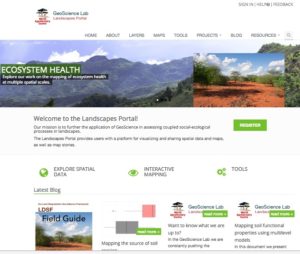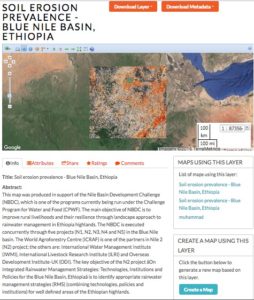
By Kerstin Reisdorf
It sounds like not only the CIA’s, but also a scientist’s worst nightmare: tons of datasets just “lying around” or rather sitting on someone’s computer without anyone else knowing. This is all too common and was what happened with geospatial data at the World Agroforestry Centre (ICRAF) before the creation of their GeoScience Lab. When data are not organized it means, of course, that they are not accessible for others and therefore cannot be put to any use.
Around 2011, ICRAF decided to address this problem, both to improve data management and use internally and in response to several donors that wanted to see more research outputs shared between scientists. Enter: ICRAF’s data geeks.
In 2012, Geoinformatics Senior Scientist Tor-Gunnar Vagen and his colleagues created a system in which spatial data analysis becomes an integral part of research projects: the so-called Landscape Portal.
This is a strictly open-source, interactive tool not only for scientists in ICRAF.
Now, four years later, the Portal counts between 100 and 300 users per day from all over the world—and is set to enter its next phase with more features and improved ease of use.
How it works

The maps on the Landscape Portal come from a range of projects, including from historical datasets and larger research programmes such as FTA’s Sentinel Landscapes Initiative, covering thematic areas ranging from soil mapping, assessments of land degradation, Farmer-Managed Natural Regeneration, biofuels and household surveys. These datasets and maps yield a wide range of biophysical parameters for properties such as soil health or tree cover. Each map contains different layers for each of the various properties it documents.
“The layers feed into a map-making interface in which a user can combine the information from one layer with a different dataset from the same geographical entity,” Vagen explains. By clicking on the maps, windows with measured values pop up that show variables such as the pH-status of a certain point in the map or the rainfall at a certain time.
“Right now, everyone who registers on the Portal, and not only ICRAF staff, can use the existing data, and also upload their own maps in any format they like,” Vagen explains. To make sure that the data is valid and can be tracked, they need to also provide the metadata to the spatial data layer (see screenshot).
“We have to know what the project is about, where it is located and so on,” says developer Muhammad Ahmed, “because we had attempts of jokers who tried to put up some rubbish maps. We need quality control.”
Sharing data with responsibility is his motto. And he stresses that such a data infrastructure needs constant maintenance, which is paid for by the projects to keep it a global public good.
Currently the Landscape Portal contains over 1500 unique datasets that are reflected as layers in maps with the respective metadata, another 2000 are in the pipeline, which means that they are being verified before publication.
“Interestingly,” says Ahmed, “most first time users of the Portal come in through the blogs, because search engines find key words from the blogs most easily, but cannot detect the meta-data in the spatial data layers directly.”
Data sharing
Sharing data can have many benefits, both Vagen and Ahmed agree. A good example comes from ICRAF research on biofuel species and the so-called Africa Tree Finder app, which was developed with funding from the International Union for Conservation of Nature (IUCN) based on maps of potential natural vegetation in East Africa. The Geoinformatics specialists realized that the map on biofuel species was complementing the Tree Finder map as the data from the former could be used to validate the latter.
Ahmed also sees the potential of saving money if scientists from one project are aware of data collection conducted in other projects and can better coordinate or even supplement data these efforts. “We’d ask them to either share their data with us or even modify their survey a little bit. And this can save a lot of money.”

The Geoinformatics researchers are working to connect with scientists outside of ICRAF as well and are working on a number of joint projects with external partners. For example, a collaboration with the University of Pennsylvania is looking at the use and distribution of Croton as a biofuel in Kenya.
“Since ICRAF scientists go out into the field anyway, other organizations and universities could collaborate with them for their research projects and data sharing,” Ahmed says.
Sentinel Landscapes
The Landscape Portal is the official spatial data platform for Sentinel Landscapes project of the CGIAR Research Program on Forests, Trees and Agroforestry (FTA). All datasets generated in the ten Sentinel Landscapes that are currently in the database will over time go up on the Portal, which already holds about 150 unique datasets from these landscapes.
“Although finalizing the tremendous amount of data generated from the ten Sentinel Landscapes might be slower than we’d hoped for, we are proud that the Landscape Portal is the first of its kind in terms of capturing geographic, biophysical and social data which is a huge achievement already,” says ICRAF’s Deputy Director General Research, Ravi Prabhu.
Coming up
For the Landscape Portal’s next version, the developers have introduced web processing services so that the portal can produce maps according to users’ demand. Those maps will be ready “on the fly” and provide data in real-time. More importantly, the new Landscape Portal will make it easier to browse the layers and find data, Vagen explains, including location-based queries or searches. The Geoinformatics experts have also embedded an open-source modelling statistics platform called R-Statistics into the backend of the Portal. This will allow the Landscape Portal to run advanced statistical models in the back-end for analyses and mapping, and for the creation of Dashboards.
In the next phase that will be launched before the end of the year the Landscape Portal will also be connected with ICRAF’s Central Project Management System. As a consequence, anyone who enters their approved project into this database, which is compulsory, can also automatically also store and tag spatial datasets that are associated with their project on the Landscape Portal.
“The ultimate goal is to be able to create a map that shows where ICRAF is doing what kind of work and what stage it is at,” Ahmed says. “That way, others can take advantage of us being in a certain area to get their surveys done as well.” And this would be any scientist’s dream come true.
The Landscape portal is based on GeoNode, an open source spatial content management platform.











